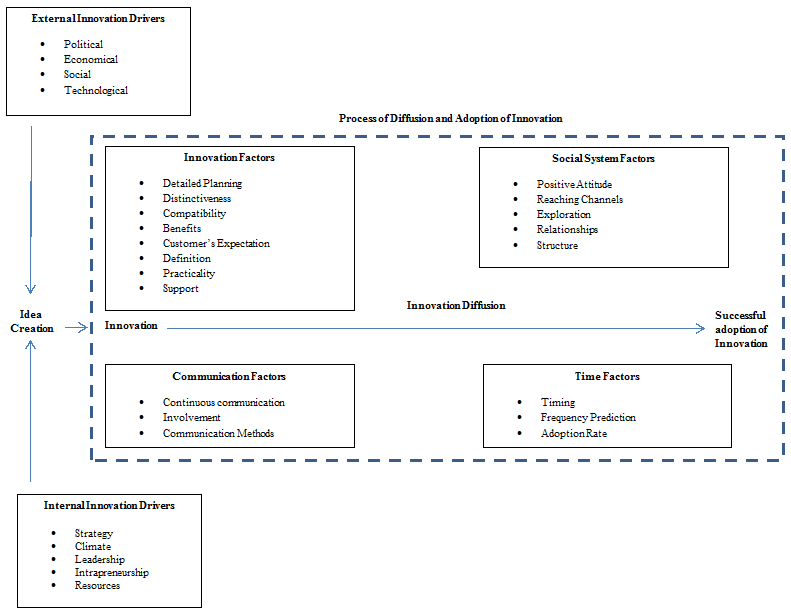A Practical Model for Diffusing Innovation: A Case Study on Meirc Training & Consulting

Introduction:
Diffusion of innovation is summarized as the spread of abstract ideas and concepts within the organization. Furthermore, innovation diffusion is considered as foundation for any change in the organization. The origins of the word “innovation” emphasize this relationship between change and innovation where it originates from the Latin word “innovare” or “novous” leading to the same meaning: to review, to make new or to alter. Due to the importance of innovation diffusion; Meirc created an innovation culture that lead to changes in its employees’ thoughts and behaviors.
Discussion:
This section suggests a practical model for the successful diffusion of innovation in Meirc. The discussion includes analysis of Critical Success Factors (CSFs) for the successful diffusion of innovations in Meirc. The impact of these CSFs on the success of projects will be analyzed using two selected projects from Meirc. As for innovation drivers; they were discussed thoroughly in a previous article.

Figure 1. Practical Framework for Innovation Diffusion in Meirc Training and Consulting.
Critical Success Factors for Innovation Diffusion in Meirc:
The critical success factors for innovation diffusion in Meirc were organized under four clusters: Innovation, Communication, Social System and Time.
Innovation: relates for planning the innovative idea launching and the uniqueness of this idea. It also covers the benefits of the ideas from customers’ perspective. The CSFs for this cluster include
- Detailed planning: detailed plan for diffusing innovation.
- Distinctiveness: uniqueness and exclusiveness of innovation.
- Compatibility: compatibility of innovation with customers’ norms and values.
- Benefits: tangible and intangible benefits provided by innovation.
- Customer’s Expectations: meeting customers’ expectations in terms of innovation quality and price.
- Definition: clear definition of the use of innovation.
- Practicality: the ease of using the innovation.
- Support: management support for innovation.
Communication: relates for maintaining open communication with all levels of the organization and using different communication channels. The CSFs for this cluster include:
- Continuous communication: open and continuous communication between the organizations’ leadership and innovation taskforce members.
- Involvement: regular communication meetings among organization internal and external stakeholders to involve them in the innovation diffusion process.
- Communication methods: using the right communication methods during the process of diffusion as well as agreeing on the communication frequencies.
Social System: relates for disseminating positive attitude among organization employees and towards entrepreneurship. It also includes choosing the right organizational structure for innovation. The CSFs for this cluster include:
- Positive Attitude: optimism of team members and external stakeholders towards proposed innovations and changes.
- Reaching Channels: using various social channels (e.g: social media networks) for reaching different stakeholders types.
- Exploration: positive attitude of team members towards entrepreneurship, exploration of new ideas and ability to learn new things.
- Relationships: building positive and rational relationships between team members that include homogeneity and transparency.
- Structure: right organization structure and climate for innovation.
Time: relates for choosing the right timing for diffusing the innovation and forecasting adoption rates. The CSFs for this cluster include:
- Timing: Appropriate and effective timings of introducing product innovation into the market and process innovation into the organization.
- Frequency Prediction: accurate frequency prediction of using the innovation.
- Adoption Rates: high rates of innovation adoption from all stakeholders
Other Critical Success Factors:
- Anticipating competition responses and actions towards the innovation.
- Sufficient number of resources working on the innovation projects.
Two Case Studies of Projects on Innovation Diffusion in Meirc:
This section discusses the analysis of Meirc critical success factors (CSFs) related to the diffusion of innovation in two projects. Face-to-Face interviews with the innovations taskforces members were conducted to relate the CSFs to the success of these projects. One project is related to product innovation; referred to as Meirc Professional Certification (MPC). The other project is related to process innovation; referred to as Category Champion (CC).
Product innovation: Meirc Professional Certification (MPC):
Introducing professional certifications recognized by international bodies in sixteen training categories. The professional certifications were earned by participants after passing an exam and submitting a project that links between theories discussed during the training workshop and the participant workplace. In discussing some CSFs; direct quotations from the interviews were used for emphasis purposes. (placed between double quotations)
Innovation:
Introducing professional certifications recognized by international bodies in sixteen training categories. The professional certifications were earned by participants after passing an exam and submitting a project that links between theories discussed during the training workshop and the participant workplace. In discussing some CSFs; direct quotations from the interviews were used for emphasis purposes. (placed between double quotations)
- Detailed planning: a taskforce was formed to plan the innovation. The taskforce “established a clear vision for designing a perfect and sustainable product”.
- Distinctiveness: the product was unique and not imitated by competition where “it was the only one in the market and clients trusted the quality of our product due to trusting our organization heritage is based on 60 years of experience.”
- Compatibility: the product was designed to satisfy the young generations need for getting certified when attending a training workshop and not only attending a regular training that ends with an attendance certificate.
- Benefits: tangible benefits were recognized such as increase in profits and intangible such as the “enhanced customer perception about our organization to innovate, brand equity improvement, and acquiring more market share”.
- Customer’s Expectations: expectations were met on quality and price fronts. A quality taskforce was formed to ensure the adherence to exam and projects guidelines. Also the price was reasonable and only slightly higher than regular pricing of a normal training course.
- Definition: the use of product was made clear by emphasizing its importance in building individuals competence and enriching their experience.
- Practicality: the innovation was an incremental innovation and not a radical one. It was easy for internal and external stakeholders to use the innovation since they were familiar with the general concept of training and building competencies.
- Support: the Managing Director was heading the taskforce as the innovation champion to emphasize management support for this innovation.​
Communication:
- Continuous communication: regular meetings were scheduled to ensure the smoothness of the process and improve the product guidelines. Also the taskforce was meeting regularly with all organization managers; “all levels of the organization were involved.”
- Involvement: a survey was administrated to test stakeholders’ satisfaction of the product.
- Communication methods: different communication channels were used with all stakeholders in which; “communication was done by highest post in the company through periodical meetings and regular circulars to reinforce the innovation standards”.
Social System:
- Positive Attitude: the innovation taskforce and employees showed optimism about the new innovation.
- Reaching Channels: the product was communicated to all stakeholders using different social media channels: website, LinkedIn, Facebook and Twitter.
- Exploration: management encouraged the exploration of new certified programs regardless of their profitability.
- Relationships: the importance of teamwork was emphasized by management and a performance measurement was added to all employees related to collaboration and teamwork.
- Structure: a professional certification unit with a formal structure was established to operate the innovation after the innovation task force finished the diffusion and adoption processes.
Time:
- Timing: the product was introduced after testing it on a pilot sample where only few certified programs were designed under few categories. After the pilot testing success, the idea was expanded to include all other sixteen categories.
- Frequency Prediction: the survey results showed that there will be high frequencies of using the products and customers were demanding more certified programs.
- Adoption Rates: many clients adopted the innovation and sent their employees only to certified programs.
Process Innovation: Category Champion (CC):
Creating a category champion role for each of the sixteen training and consulting categories listed in the directory of services. The category champion is responsible to maintain the quality of all courses and services offered within his category. Every course within the category will have a champion but the role of the category champion will be to supervise the following: topics, material updates, updated research, courses frequencies and locations.
Innovation:
Detailed planning: a “directory of services” taskforce was formed to plan this innovation in the process by having a clear vision of “avoiding diluting existing specialists and creating subject matter experts that act as category champions of relevant areas of their expertise.” Distinctiveness: it is a unique process innovation unlike competition which depends on hiring “free- lancers to deliver assignments and not fully employed consultants and trainers as the case with our organization.” Compatibility: the initiative was triggered by customers demand to allocate subject matter experts for any training and consulting assignment. “This innovation satisfied a customer value of having the best specialized person to deliver a course or a consulting job.” Benefits: the internal process became smoother where every category champion was responsible for handling all customers’ requests and queries related to his category. It also increased the quality of the final products (such as material quality, better selection of topics and locations). Furthermore, the category champions assisted in increasing their category products as well as their billing days.
Communication:
Continuous communication: the “directory of services” taskforce met regularly with category champions who acted as representatives of all other champions within their category. Involvement: all consultants and trainers were involved in the innovation since it affected their workload and responsibilities. Communication methods: two-way communication channels were used for implementation of the innovation and one-way channels for follow-up.
Social System:
Positive Attitude: the team showed extreme positive attitude about the innovation because it empowered them to be responsible of their categories. Reaching Channels: category champions conducted presentations, show cases, and webinars to reach to different stakeholders.
Time:
Timing: the innovation was introduced after building the knowledge base for every category champion by sending them to formal training sessions and getting them certified in areas relevant to their categories. The innovation took place “after making sure of the following: flagging specialty of trainers and consultants and making sure that there is someone who can be assigned as category champion based on their specialty.”
Adoption Rates: the adoption rates were very high to the extent that many consultants wanted to create new categories and champion them. As stated by the Managing Director: “when you integrate innovation within performance and you design performance indicators that track it and measure it, you make innovation part of everyone’s job. And when you reward such initiative, you elevate the importance of innovation across the organization.”
In summary, the article suggested four clusters for organizing critical success factors for the diffusion of innovation: innovation, communication, social systems and time. Critical Success factors related to innovation cluster can be summarized in: detailed planning, distinctiveness, compatibility, benefits, customers’ expectations, definition, practicality and support. The critical success factors related to communication cluster are: continuous communication, involvement, and communication methods. As for the social system cluster; it included the following critical success factors: positive attitude, reaching channels, exploration, relationships and structure. Lastly, the critical success factors related to time cluster are: timing, frequency prediction and adoption rates. The advantage of the above suggested model for innovation diffusion is in giving more flexibility for training and consulting organization to develop its own critical success factors under the four suggested clusters.
It is still important for further research to be conducted in the area of successful diffusion of innovation in training and consulting organizations to analyze the relationship between the critical success factors suggested above, specifically: the sequential relationship between the factors and the weight each factor plays in the success of diffusing innovation in the organization.
Related Articles

The illusion of control: Unmasking the Paradox of Readiness
Mike Tyson famously said: “Everybody has a plan until they get punched…

Unlocking Business Wisdom: Khalil Gibran's Timeless Insights
Gibran Khalil Gibran was a renowned Lebanese American poet, writer, and…

Am I Mr. Nice Guy or A People-pleaser?
I wanted to share a question that's been on my mind. I recently listened…

My adventure in the world of virtual learning
The traditional concept of education has changed radically over the past…
